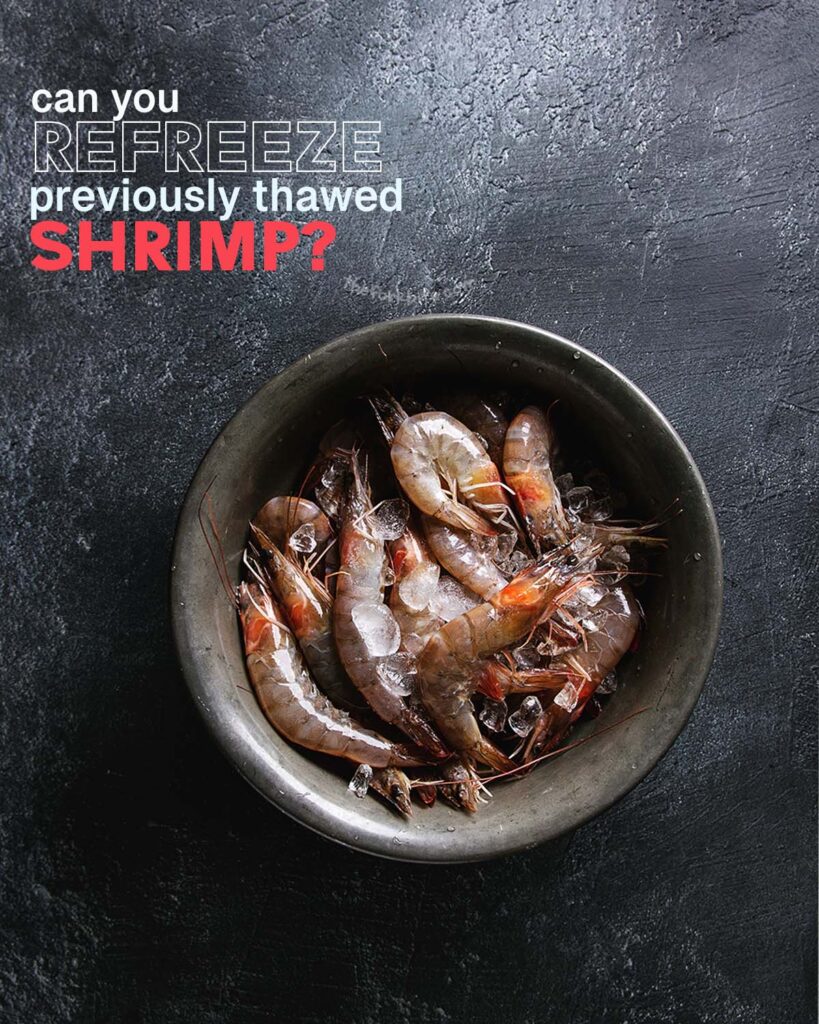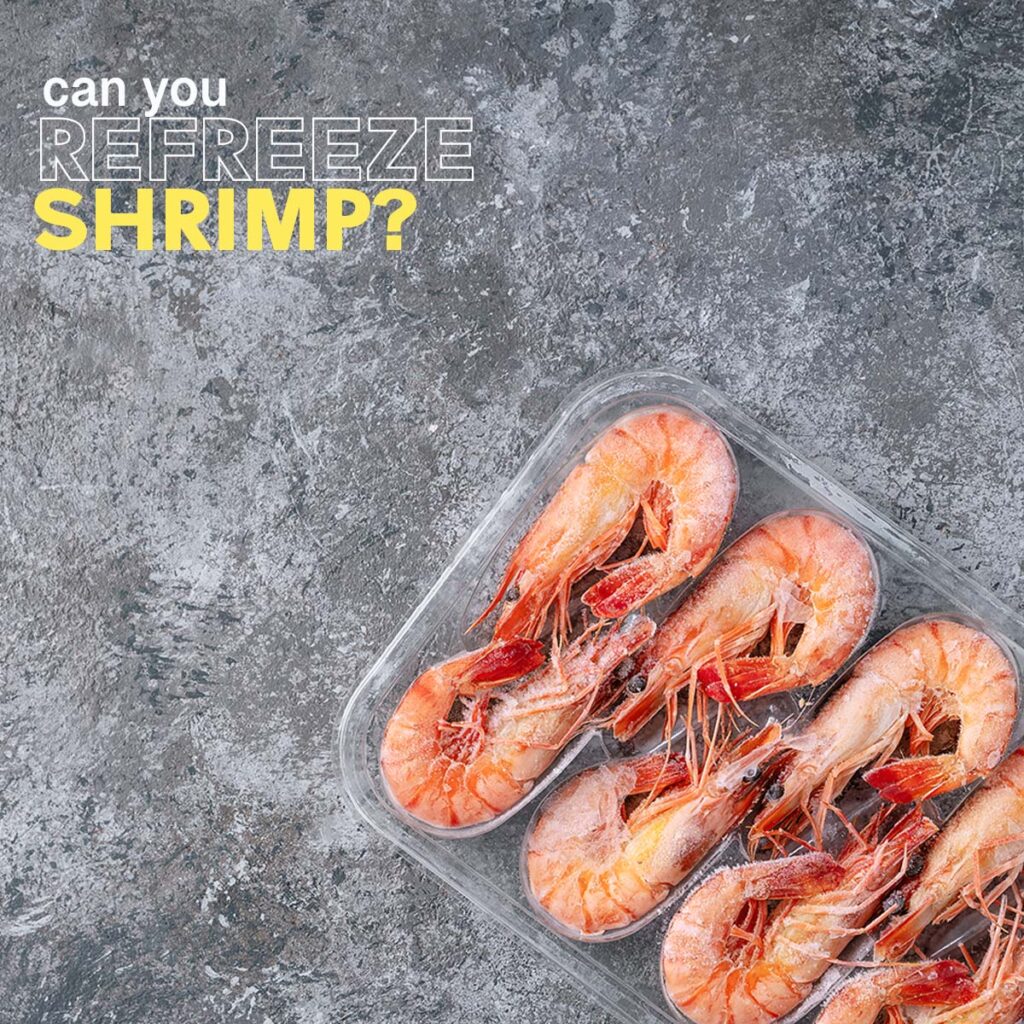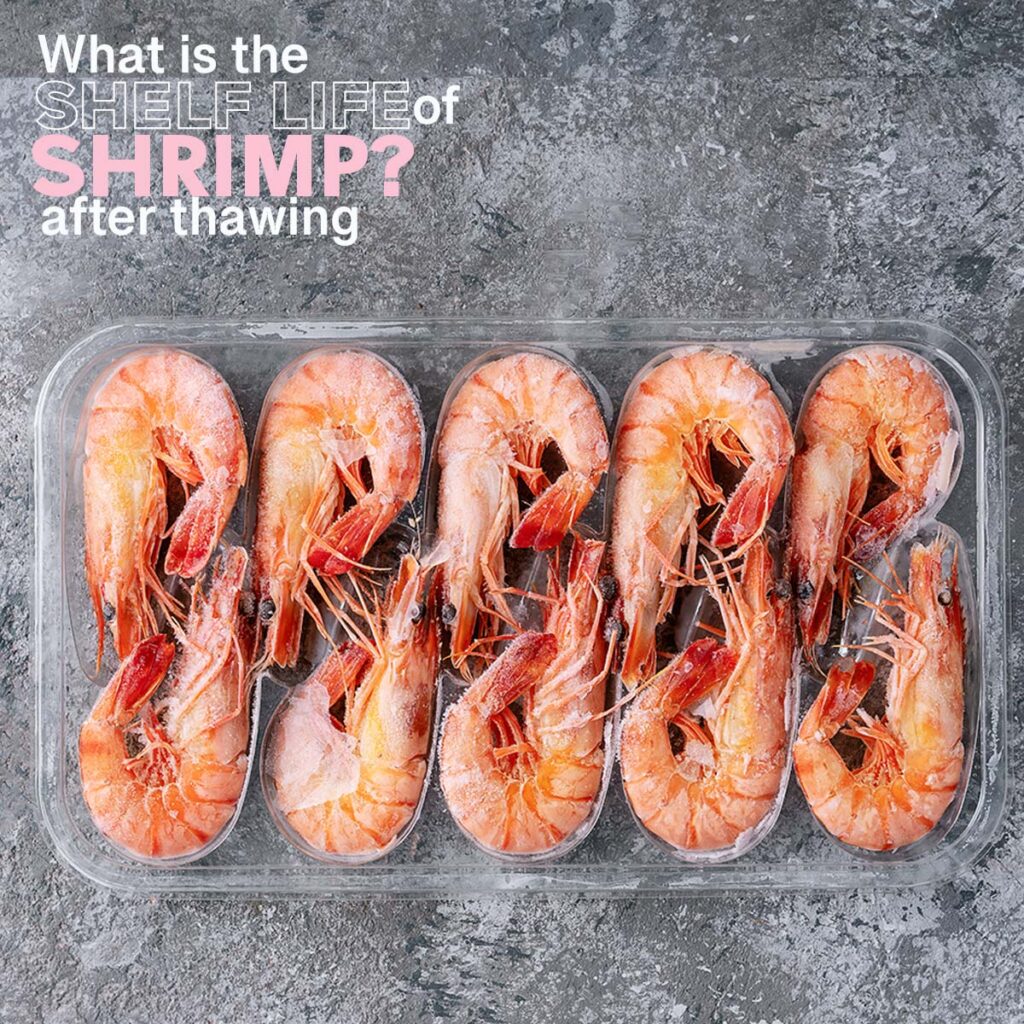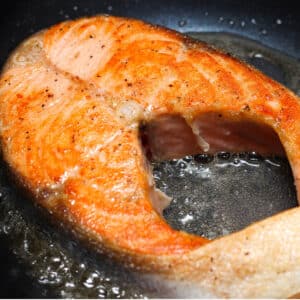If you want to use the defrosted shrimp that you've unfrozen previously, chances are you're curious whether it is feasible to refreeze them. When refreezing shrimp, whether raw or cooked, you should observe a few safety precautions. Here's what you need to know, please read on.
So, can you refreeze shrimp?
Quick answer. Yes. Thawing is the key to being able to refreeze seafood. It is possible to refreeze shrimp, assuming you have implemented the proper thawing method. And the safest way to thaw shrimp is in the fridge. It takes 12 to 24 hours to defrost shrimp in the refrigerator; hence, refreezing is safe without compromising taste or texture.

Seafood like shrimp is among the best on earth. Raw or cooked, such as shrimp ceviche, barbecued, boiled, fried, or grilled, can be eaten this way. The preparation takes just a few minutes - literally three or four minutes.
Read: Costco Cilantro Lime Recipe Recipe (Copycat)
This combination is great in Spanish Garlic Shrimp (Gambas al Ajillo) - I have to admit that this is my favorite shrimp dish. It wouldn't be complete without a few fresh slices of baguette and a glass of cold, white wine to mop up all the sauce. There is no better dish to share with your friends if you are looking for a quick and easy meal to enjoy together.
The effect of freezing and refreezing
When anything is frozen, a portion of the cell walls is ruptured. It explains why frozen food does not taste as good as fresh food. That's why frozen foods are often more affordable than fresh — and this particularly holds for meat and seafood.
A product that has been frozen, thawed, and then refrozen will lose even more moisture and become damaged from the second thaw. There are also bacteria to worry about, developing faster on frozen and thawed food. Your food starts developing these nasty bugs once the ice crystals are gone.
The thawing and freezing of foods pose a significant risk to food safety. Restaurants and grocery stores are subject to legal restrictions to keep everyone safe. It is equally important to apply these same principles to our own homes.
Can you refreeze shrimp?
Yes, you can do it. However, thawing is of crucial importance. The way the shrimp are unfrozen is what matters most.
The safest way to thaw shrimp is to put them in the refrigerator to avoid bacteria growth. You can leave them for up to 24 hours so that they can defrost thoroughly, or you can leave them overnight.
Countertop thawing is never safe. Just the opposite, if you unfroze shrimp in the microwave or cold running water, you should cook shrimp on the same day. So if you plan to refreeze your shrimp, neither of these defrosting methods is applicable. If you thaw food in cold water, you should cook it before refreezing.

In some instances, it is not the best idea to refreeze seafood that has already spent a long time in the freezer. The shrimps can remain much juicier in texture by following the correct safety precautions.
It is never safe to let frozen shrimp defrost on the kitchen countertop at room temperature because that can lead to bacterial growth. I don't mind defrosting in cold water or the microwave, as long as you cook the shrimp the same day as you defrosted them.
Is it safe to thaw shrimp and then refreeze them?
There is nothing wrong with refreezing seafood, especially shrimp. Though some crustaceans usually have a bad reputation for keeping well when frozen.
The first step you need to take is to make sure you know what condition the shrimp were in when you bought them in the first place. Was the product you purchased frozen or was it "previously frozen"? Fresh or frozen seems obvious.
However, keep an eye for previously frozen shrimp. The first freeze already happened, so no second freeze is necessary! Many seafood items, including shrimp, are delivered to the store frozen but defrosted before being displayed.
How to refreeze shrimp?
Refreezing shrimp is the best option to keep your shrimp fresh and flavorful. Other techniques might affect the texture and decrease their longevity.
The following steps might prove helpful for refreezing shrimp.
- Before putting cooked shrimp in the freezer, they should be allowed to cool down for a few minutes. When they are cooled, they are less likely to get freezer burns.
- When preparing raw shrimps, keep the shell intact and do not remove the shell at any point. The outer casing serves as a protective covering for the meat inside.
- Raw and cooked shrimp essentially need to be stored in an airtight container or a freezer-safe bag for storage in the freezer. It will stop other food flavors from getting absorbed by them.
- Then, place the bag or container in a safe corner of the freezer and let it freeze for the duration of the set time.
- It would be better if you labeled the bag with the date of refreezing to keep track of this.
It is never sensible to thaw frozen shrimp at room temperature or in hot water, as this leads to the growth of harmful organisms. As a reminder, you should know that constant freezing and refreezing of shrimp negatively affect their flavor and texture. Do not refreeze shrimp more than once.
Avoiding danger zone
Food safety danger zones are common knowledge. We mean how increased bacterial growth rates can compromise fresh foods at different temperatures during storage. As per the USDA, the temperature can range between 40°F and 140°F.
You can inhibit bacterial growth as the temperature drops below 40°F, as they do not have the opportunity to multiply. At a temperature of over 140°F, they will thrive and reproduce incredibly.
Food safety is at risk when frozen shrimp are refrozen, so you must limit the exposure to this area as much as possible. It is not wise to leave food outside the fridge at room temperature for more than two hours.
Nevertheless, if the temperature is 90°F or higher, you will be limited to leaving food out for one hour at the most.
When taking frozen shrimp home with you, it's good to place them in a cooler bag and a few ice packs to remain cold while you drive home. When you arrive home, you should put them straight into the fridge when you get home.
What is the shelf life of shrimp after thawed out?
Once frozen shrimp begin to defrost, they become vulnerable to bacterial growth. Although it is unfrozen, you can safely prolong its shelf life for up to two days inside the fridge, based on USDA recommendations.
It is better to store the shrimp in your freezer than put them in your fridge if you decide you won't be cooking them the next day or two. The same applies to store-bought thawed shrimp as well.

Make it a point to label each shrimp package that has been defrosted at least once so that you can be more cautious. If you did that, whoever took the foods out of the freezer would know they needed to cook the shrimp immediately. As soon as they have defrosted a second time, it is risky to put them in the freezer again.
When defrosting them in the microwave or submerging them in cold water, remember to use them as soon as possible and not freeze them again.
If you use a microwave or cold-water method of thawing, you allow the temperature to rise above 40°F, which is a level that activates the food danger zone, thus allowing bacteria to grow.
How to thaw shrimp in the most efficient way
Step 1
It is important to defrost the shrimp in the refrigerator, not at room temperature or cold water. Ensure that the wrapped package sits in a bowl, where any moisture that drips from it can be caught.
Step 2
If your shrimp packaging is wet, replace the bowl with a dry one after thawing. You can keep the shrimp in the fridge for one to two days.
Step 3
Unless you can serve it within two days, wrap it up in fresh plastic or butcher paper. Place in an airtight container and stick it in the freezer for up to three months.
Does refreezing shrimp affect its flavor?
There is a high percentage of water in shrimp. The amount of moisture in shrimp is about 80%. Since liquids expand when they freeze, the high moisture content of shrimp will result in some cell ruptures when they freeze. The problem is that you cannot avoid it.
When you thaw shrimp, moisture leaks out of the flesh, rendering it less moist and juicy than fresh shrimp or shrimp that has gone through the thawing process only once. The shrimp will lose its natural firmness and become mushy in some cases.
If you defrost shrimp twice, it's best to use them in casseroles, sauces, and soups. It will disguise the mushy texture to a certain extent.
How to Tell if Shrimp Has Gone Bad
As mentioned above, the easiest way to determine if shrimp have gone bad is to smell them. They have an unpleasant stench, similar to that of ammonia. Do not eat the shrimp if they smell funky - throw them away if they are.
1 Spoiled Shrimp Smell
The best place to buy fresh fish is at the supermarket's fish counter or your local fishmonger. Smell the shrimp before you purchase them. Avoid the pre-packaged shrimp since you cannot smell the shrimp once wrapped in plastic.
If there is any whiff of ammonia odor in your shrimp, that isn't nice. When you buy fresh shrimp, you will smell the aroma of seawater.
2 Shell Appearance
You can determine the freshness of shrimp by checking the texture. It must be firm, and the shells should not be loosely attached to the shrimp's body. If you can easily remove the shrimp's shells, there is a possibility that they aren't fresh, and you will likely notice an unpleasant odor.
3 Shrimp Colors
Some fishmongers use a trick to coat shrimp with sodium bisulfate. In addition, this chemical prevents shrimp shells from developing a condition known as melanosis (or black spots).
A darkening of the shrimp's head and shell occurs after being harvested and exposed to oxygen. The downside, however, is that it is not always obvious.
What is freezer burn?
A chemical process known as sublimation is responsible for freezer burn. Frozen food is subjected to freezer burn when moisture is lost. As a result, meat sitting in your freezer for a long time begins to lose moisture and appear discolored or dried out. This dehydration and oxidation cause the food to dry, affecting its flavor and texture.
What causes it?
A freezer burn is not technically a burn. It is a result of dehydration. It occurs when improper freezing practices or air exposure takes place. Generally, the foods we eat contain a large amount of water. In a sense, that's how we can freeze them by turning the water in the food into ice.
Despite being perfectly frozen, something will likely develop freezer burn with time. This phenomenon can affect all foods, but foods high in moisture (meats, fruits, ice cream, etc.) get it faster.
How to prevent freezer burn
The best way to prevent freezer burn is to ensure that you pack your food properly before it goes into the freezer. Using an airtight container or freezer bag and extracting as much air as possible will ensure that the food will last longer.
- Wrap and seal tightly. If possible, you can do the triple-wrap trick: First, you wrap the food with cling wrap or freezer paper, then encase it with a layer of foil. Finally, placing the food in the freezer bag should be enough. Don't forget to get all the air out.
- Store an open cup of water in the freezer. Water increases humidity, reducing dehydration. Although water may freeze, it still gradually evaporates. The objective is for this to happen.
- Only thaw once. It's easier to thaw what you need at a given time if you freeze it in small amounts. By thawing and refreezing something repeatedly, you increase the risk of freezer burn.
- Maintain the proper temperature in your freezer. Freezing occurs more quickly below 0° Fahrenheit. The faster the freeze, the smaller the ice crystals. Fewer ice crystals, less chance of freezer burn.
- Close your freezer as soon as possible after opening it. Whenever possible, go in and out quickly. Keeping the freezer door constantly open will cause temperature instability, accelerating the formation of ice crystals.
To keep the food fresh, I strongly recommend vacuum-sealing the bags so that they do not contact the air, thus preventing moisture from evaporating. This is because air will not be able to reach the food, so freezer burn will be less likely to occur.
Signs of freezer burn shrimp
If there are gray spots or dry patches on your shrimp, there is a good possibility that they have been freezer burnt.
There are other signs of freezer burn as well, including:
- appear tough or rigid exterior
- Shriveled
- dry patches of discoloration or dryness
- irregular blemishes
- covered in ice crystals
- White or opaque spots on the skin
In some cases, an entire pack of frozen shrimp may be freezer burnt, but it may only affect a small percentage of the package.
Despite this, it is good to know that freezer burn does not mean that you cannot eat shrimp. Even though it is still edible, the flavor and texture may have been negatively affected.
Freezer burns can be an incidental complication. There is always the possibility that shrimp will still get freezer burnt no matter how carefully you pack them before they are frozen. This is simply the way things are.
Assessing food safety
The smell is one of the first indicators that you can't eat your shrimp since they aren't safe to consume.
As long as the shrimp haven't been thawed, they will not release any odor. In the process of cooking, you might be able to detect it. However, you do not have to get too close to the splatter to avoid getting burned.
When cooking shrimps, the best thing you can do is take a quick taste test. It would be best to throw them out immediately whenever you detect an odor or taste that reminds you of ammonia.
Cook shrimp until the internal temperature reaches 145°F as a safety precaution. Ideally, at this stage, the shrimp should be opaque, pearly white, and have bright pink stripes. If you are unsure about the temperature of the shrimp, use a food thermometer.
Can you cook frozen shrimp without thawing them first?
In the case of frozen prawns, you can directly cook them from the freezer. However, this will result in a longer cooking time since the prawns will need more time to cook evenly.
Fresh or defrosted shrimp can be cooked in just two to three minutes, whereas frozen shrimp require up to five minutes. The longer you let them cook, the more likely they will turn mushy.
The good news is that the shrimp keeps its flavor and texture despite the prolonged cooking time.
1 Precooking preparation
Shrimp have black veins running along their backs, known as dorsal veins. The little black strings running along their backs act as their digestive tracts. Nevertheless, the deveining of shrimp is a subjective decision and doesn't necessarily concern sanitization.
It has been my experience that cooking shrimp with the black string intact did not adversely affect the shrimp taste. However, on rare occasions, if the tract was exceptionally prominent, it could impart some grit to the texture of the shrimp. Despite this, eating the crustacean with the black string will not cause you any harm.
How to take the shell off
The process of shelling shrimp involves pulling off their heads. Removing their spindly legs and picking off whatever is left off their shells. It is impossible to shell frozen shrimp; you must defrost them first.
- To remove the shrimp, you need to run a sharp knife down the back of the shrimp to expose the vein.
- Then gently pull the shrimp with your fingertip by grabbing one end of the vein between the knife blade and your finger.
2 Boiling or Adding to Sauce
The shrimp shell needs to be intact if you will cook frozen shrimp. The simplest method of cooking frozen shrimp is by boiling them. As the ice-coated shrimp melt in the sauce, it adds extra moisture to the dish.
The shrimp flavor will infuse the water as it reduces, and you will be able to taste it as it thickens. Also, frozen shrimp only requires approximately five minutes to be cooked through.
3 Grilling, with Accommodations
If you want to cook shrimp from frozen, there are other ways. You can prepare them in several ways, such as grilling or broiling them, as shown in this recipe for Cajun shrimp.
But here's the deal. A thin layer of ice covered the shrimp during the freezing process, preventing the spices mixture or marinade from sticking to the frozen shrimp.
To avoid this issue, you can grill or broil shrimp for a minute. Once they thaw, it is easier to marinate or add some seasoning.
The other option is to rinse them in cold water to remove the thin layer of ice formed on their surface. Then, you can toss the shrimp in the marinade and grill or broil for four minutes. This will make the shrimp very tender and tasty.
4 Sautéing with Caution
Another way to prepare frozen shrimp is to fry or sauté them. As the shrimp melt when they contact with hot oil or butter, the moisture will leak out—one thing to watch out for is the hot splatter from the oil.
The liquid will spit out during this process, so be careful not to burn yourself. You might want to protect your hands by using oven gloves.
The sautéing process is again quite simple - five minutes at most. Using medium to low heat, cook the shrimp until the ice evaporates, and they attain that delicious pink color.




